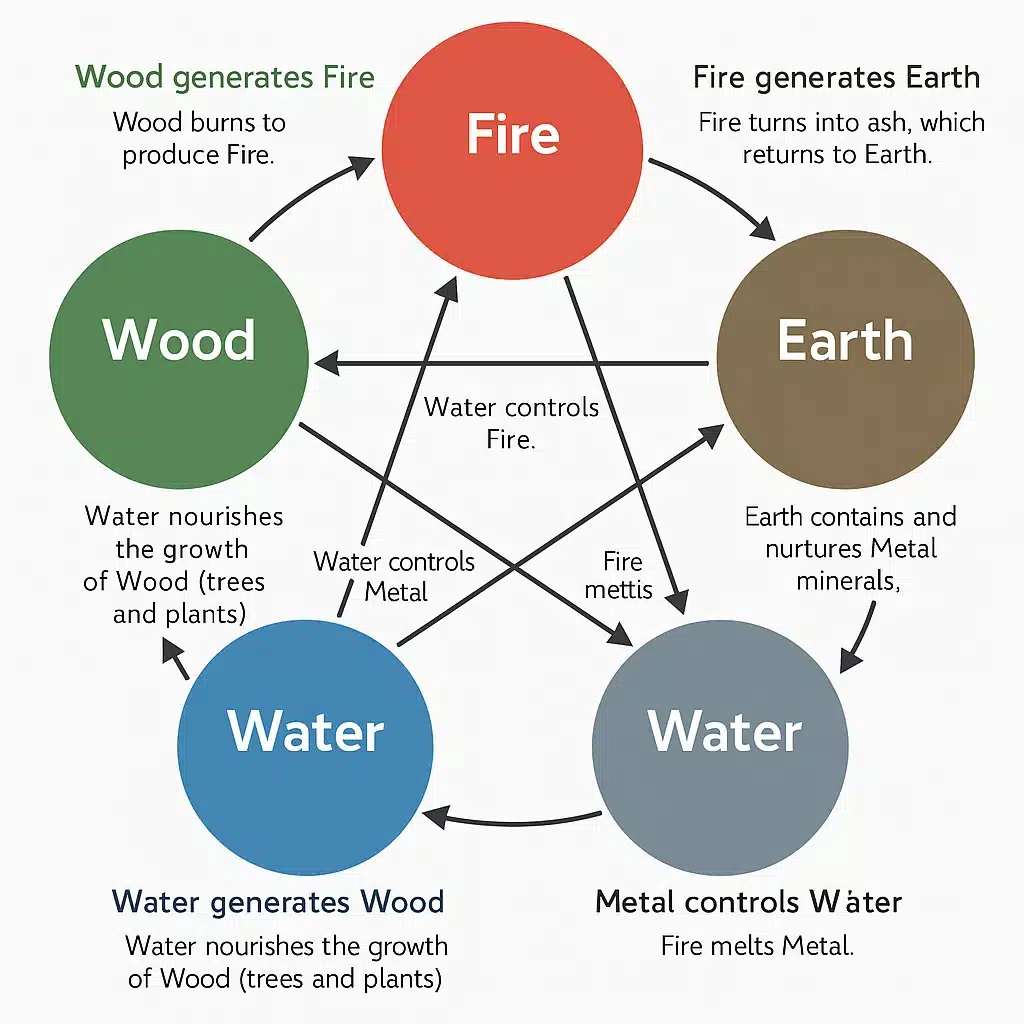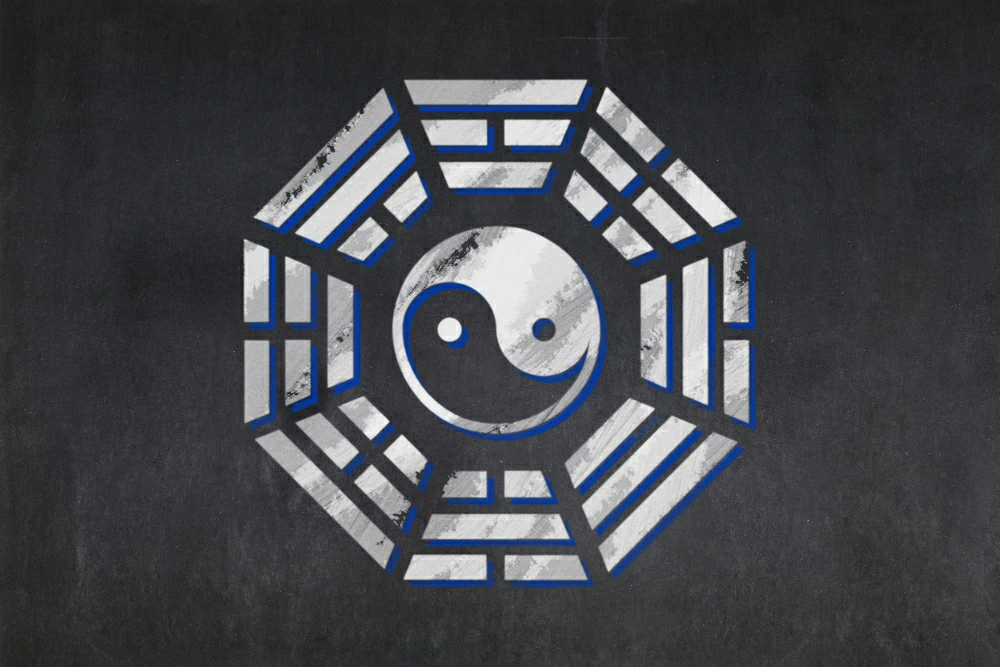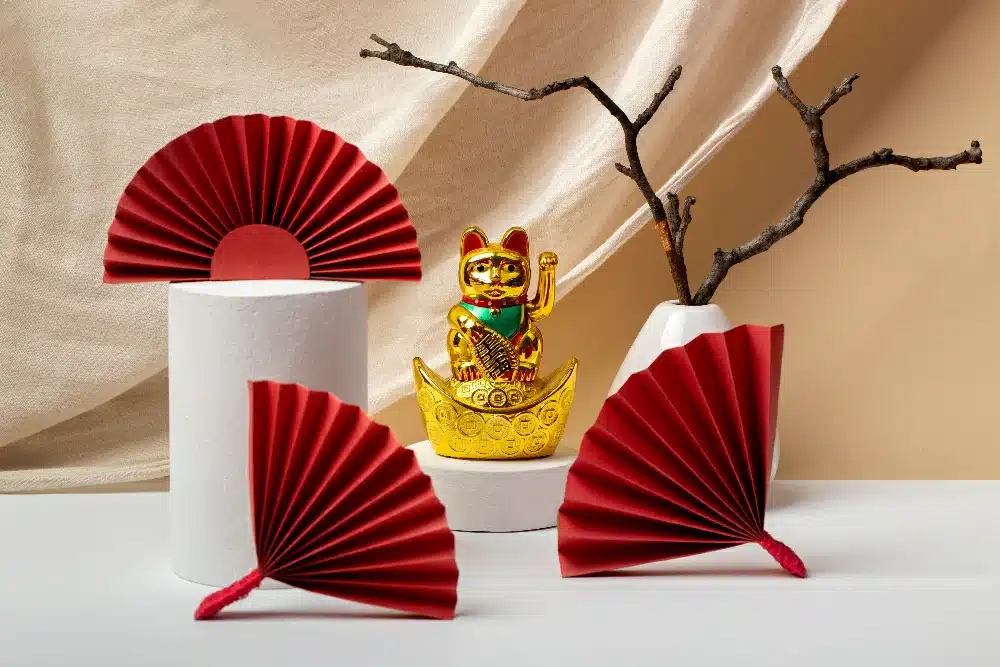Feng Shui Basics: The Five Elements and Bagua
- March 16, 2025
- Sunflower
Feng Shui, an ancient Chinese practice, emphasizes the harmonious coexistence between humans and their environment. At its core lies the Five Elements and Bagua Theory, which posits that Wood, Fire, Earth, Metal, and Water are the fundamental elements constituting the universe. These elements interact through cycles of generation and restriction, maintaining the balance and harmony of nature.
Understanding the meanings and interrelationships of the Five Elements and Bagua is essential to mastering Feng Shui. Whether it’s arranging your home, optimizing your workspace, or enhancing personal fortune, the Five Elements and Bagua provide guidance to create a more harmonious and positive living environment.
1. Detailed Explanation of the Five Elements

Wood
In the Five Elements theory, Wood is vividly described as "bending and straightening."Bending means it can yield and adapt when necessary, while straightening signifies its ability to stand tall and take the lead. Since Wood governs growth, anything associated with it tends to rise upward and expand outward. For example: A character that is energetic, warm, tolerant and compassionate (Ren, or benevolence);Usually tall and slender with long fingers;Understand the importance of steady progress, and know when to move forward and when to retreat.This is why the ancient saying "Wood embodies benevolence" (Mu Zhu Ren) holds true. A great tree provides shelter for birds and shade for people—its selfless nature is the purest expression of *Ren*. When we praise someone for possessing the "virtues of a gentleman," we are, in essence, describing the qualities of Wood—resilient yet adaptable, ambitious yet deeply rooted.

Fire
In the Five Elements theory, Fire is described as "blazing upward" (Yan Shang), a strikingly vivid depiction. "Blazing" (Yan) refers to its intense heat, while "upward"(Shang) represents its rising nature. Fire's temperament is much like a flickering flame—radiating heat and energy while always surging upward.Interestingly, Fire is actually the "child" of Wood (Wood generates Fire). Just as burning wood produces flames, people with fiery tempers often start from a calm state before being ignited. Despite Fire’s explosive nature, Fire-dominant individuals tend to value rituals and etiquette (Its emotions are respectful). Like flames that burn upward in an orderly fashion, Fire doesn’t spread recklessly—it follows a natural course.In essence, Fire-dominant people are like walking suns—passionate when needed, disciplined when required. This perfect balance between fiery enthusiasm and respectful restraint is the ultimate expression of Li (propriety).

Earth
In the Five Elements theory, Earth is described as "sowing and harvesting", a phrase that perfectly captures its steady and dependable nature. "Sowing" represents planting seeds in spring, while "harvesting" signifies reaping in autumn. Earth’s temperament is like that of a seasoned farmer—working quietly, patiently waiting for the fruits of labor.Earth’s personality is like that of an honest and reliable person: Trustworthy (If it promises to grow crops, it will deliver),Humble and grounded(Even when stepped on, it remains silent),Selfless and generous (It provides whatever is needed).

Metal
In the Five Elements theory, Metal is described as "Compliance and Reform", a phrase that perfectly embodies its dual nature."Compliance" means being flexible and adaptable when necessary, while "Reform" signifies the ability to cut away the old and embrace change decisively. Metal’s personality is like high-quality steel—soft enough to be stretched into fine wires, yet strong enough to slice through iron.Metal’s dual personality makes it fascinating:It can be gentle and accommodating.But when the situation calls for it, it can be unyielding and sharp.This is why the ancient saying "Metal embodies justice" is so fitting—like a true warrior:It takes action when needed(Decisiveness in reform). It knows when to step back (Obedience when necessary).It operates with strict principles(If it says it will cut your left cheek, it won’t cut the right). Dealing with Metal-dominant people is always straightforward. They carry an invisible scale with them—measuring right from wrong with absolute clarity. Their words may be blunt, but if they promise something, they'll keep their word even if a knife is at their throat.

Water
Water is described in the Five Elements theory as "Moistening and Descending" (Run Xia), a phrase that vividly captures its nature. "Moistening" means it nourishes and penetrates silently, while "Descending" reflects its tendency to flow downward. This makes water’s personality resemble that of a hidden sage—calm on the surface, yet profoundly deep inside. Water’s survival philosophy is exceptionally wise: It flows around obstacles rather than confronting them head-on (flexibility over rigidity). It retreats and hides in times of drought, waiting for the right moment (adaptability and patience). It stays still when needed, never making unnecessary ripples (wisdom in stillness). This is why the ancient saying "Water embodies wisdom" (Shui Zhu Zhi) is so fitting. True intelligence is like water: When it's time to be sharp, it penetrates instantly (moistening and nourishing).When it's time to hide, it sinks deep without a trace (flowing downward and staying discreet). It always takes the most effortless and effective path (going with the flow).
2. The Generating and Controlling Cycles of the Five Elements

The Five Elements do not exist in isolation; they interact through Generating and Controlling relationships, maintaining a dynamic balance in nature.
2.1 Generating Cycle:
2.2 Controlling Cycle :
3. The Principles of the Bagua

3.1 Composition of the Bagua:
Qián (☰): Represents Heaven, symbolizing creativity and leadership.
Kūn (☷): Represents Earth, symbolizing nurturing and inclusiveness.
Zhèn (☳): Represents Thunder, symbolizing action and transformation.
Xùn (☴): Represents Wind, symbolizing flexibility and adaptability.
Kǎn (☵): Represents Water, symbolizing wisdom and flow.
Lí (☲): Represents Fire, symbolizing passion and brightness.
Gèn (☶): Represents Mountain, symbolizing stability and stillness.
Duì (☱): Represents Lake, symbolizing joy and communication.
3.2 Relationship Between the Bagua and the Five Elements
In the I Ching system, there is a clear correspondence between the Eight Trigrams (Ba Gua) and the Five Elements (Wu Xing). This relationship is widely applied in Feng Shui, astrology, traditional Chinese medicine, and other fields. The specific correspondences are as follows:
| Eight Trigrams (Ba Gua) | Five Elements (Wu Xing) | Natural Symbolism | Characteristics |
|---|---|---|---|
| Qián (☰) | Metal | Heaven | Strength, authority, leadership |
| Kūn (☷) | Earth | Earth | Inclusiveness, stability, nurturing |
| Zhèn (☳) | Wood | Thunder | Growth, movement, action |
| Xùn (☴) | Wood | Wind | Penetration, adaptability, flexibility |
| Kǎn (☵) | Water | Water | Wisdom, flow, danger |
| Lí (☲) | Fire | Fire | Brightness, passion, transformation |
| Gèn (☶) | Earth | Mountain | Stillness, solidity, accumulation |
| Duì (☱) | Metal | Lake | Joy, communication, sharpness |
Key Analysis:
Qián (☰) and Duì (☱) belong to Metal:Qián represents Heaven, symbolizing supreme power, corresponding to the firmness and authority of Metal.Duì represents Lake, symbolizing communication and interaction, corresponding to Metal’s sharpness and transformative nature (as metal can be molded into various forms).
Kūn (☷) and Gèn (☶) belong to Earth:Kūn represents Earth, symbolizing the nurturing and motherly force that sustains all things, corresponding to Earth’s inclusiveness and nourishment.Gèn represents Mountain, symbolizing stability and obstacles, corresponding to Earth’s ability to accumulate and solidify.
Zhèn (☳) and Xùn (☴) belong to Wood:Zhèn represents Thunder, symbolizing explosive energy and action, corresponding to Wood’s growth and expansion.Xùn represents Wind, symbolizing its ability to penetrate everywhere, corresponding to Wood’s flexibility and adaptability.
Lí (☲) belongs to Fire:Lí represents Fire, symbolizing brightness and passion, corresponding to Fire’s rising and transformative nature.
Kǎn (☵) belongs to Water:Kǎn represents Water, symbolizing wisdom and fluidity, corresponding to Water’s downward movement and hidden depth.
3.3 Applications of the Bagua:
In Feng Shui layouts, the Bagua Map (also known as the Luo Pan or compass) is used to determine directions and energy distribution. By adjusting the placement of furniture and decorations, the energy flow of the Bagua can be optimized to enhance the occupants’ fortune.For example, during the construction of the HSBC Building in Hong Kong, the original design of the main entrance sparked debates among Feng Shui masters. Subsequent adjustments were made to the building’s layout, including the addition of two “Feng Shui cannons,” which are said to help neutralize negative energy (Sha Qi) and boost the company’s fortune.
4. The Theoretical Basis of the Five Elements and the Bagua
The theories of the Five Elements and the Bagua are primarily derived from ancient Chinese natural philosophy and cosmology. Below are their main theoretical foundations:
The I Ching:The I Ching, or Book of Changes,is one of the most important philosophical classics in ancient China.It elaborates on the formation and transformation principles of the Bagua. Through the interplay of Yin and Yang, the Bagua reveals the patterns of change in the universe.
The Yin-Yang Theory:Yin and Yang are two opposing yet unified forces in the cosmos. The Five Elements are a concrete manifestation of the interaction between Yin and Yang. The balance of Yin and Yang is the core goal pursued in Feng Shui.
Natural Observation:The theory of the Five Elements originates from ancient people’s observations of nature. For example, the growth of Wood, the burning of Fire, the nurturing of Earth, the hardness of Metal, and the flow of Water are all common natural phenomena.
Historical Texts:Many ancient texts, such as the Huangdi Neijing and the Shangshu,document the theories and applications of the Five Elements and the Bagua. These texts provide a solid theoretical foundation for Feng Shui.
By integrating these principles, the theories of the Five Elements and the Bagua offer profound insights into the harmony between humans and their environment, guiding practices in Feng Shui and beyond.
5. Applications of the Five Elements and the Bagua in Modern Feng Shui
Home Arrangement:Based on the characteristics of the Five Elements, arrange your home environment accordingly. For example, placing green plants (Wood) in the living room can enhance vitality, while using metal decorations (Metal) in the study can improve focus.
Personal Fortune:By analyzing an individual’s Five Elements attributes, one can identify suitable colors, materials, and directions to enhance personal fortune. For instance, someone lacking the Fire element can incorporate more red colors or wear red accessories.
Environmental Balance:Ensuring the balance of the Five Elements in living or working environments is crucial. An excess of any one element may lead to energy imbalance, affecting health or fortune.

6. My Personal Perspective
As a traditional discipline, Feng Shui holds cultural value, but it should not be blindly (superstitiously followed). Feng Shui emphasizes the harmony between humans and their environment, which is undoubtedly reasonable. While science is powerful, it is not omnipotent. In life, there are always phenomena that science cannot yet fully explain, but for which answers can be found in Feng Shui theory. Below are a few typical examples:
6.1 Sudden Change in Fortune After Moving to a New Home
Phenomenon:Some people experience smooth career progress and family harmony after moving into a new home, as if everything falls into place. Others, however, face constant setbacks and health issues.
Scientific Explanation:This may be related to environmental changes or psychological suggestions, but it is difficult to explain why different people have completely opposite experiences.
Feng Shui Explanation:The Feng Shui layout of a new home directly affects its occupants. A good Feng Shui layout gathers positive energy, benefiting the residents’ fortune, while a poor layout creates negative energy, impacting health, career, and financial luck.
6.2 Frequent Nightmares and Poor Sleep Quality
Phenomenon:Frequent nightmares and poor sleep quality, leading to exhaustion upon waking.
Scientific Explanation:This may be related to stress or anxiety, but it is difficult to explain why nightmares persist.
Feng Shui Explanation:Improper bedroom Feng Shui, such as a bed facing a window or a mirror reflecting the bed, can affect sleep quality and even cause recurring nightmares.
It is essential to understand that Feng Shui is not superstition, but rather a discipline that studies the harmonious coexistence between humans and their environment. The above cases are for reference only, and specific situations require analysis based on actual circumstances. Science is continually advancing, and in the future, it may be able to explain more phenomena that currently lack clear explanations.In summary, some seemingly “mysterious” phenomena in life may find answers from the perspective of Feng Shui. Learning some basic Feng Shui knowledge can help us better understand our environment, adjust our mindset, and create a more harmonious and fulfilling life.
7. Conclusion
The theories of the Five Elements and the Bagua are the essence of Feng Shui culture, revealing the connections and patterns among all things in nature. By understanding the meanings and interrelationships of the Five Elements, as well as the principles of the Bagua, we can better apply Feng Shui principles to create a harmonious and balanced living environment. Whether it’s home design, office layout, or personal growth, the Five Elements and the Bagua offer invaluable guidance, helping us move toward a more fulfilling and beautiful life.









